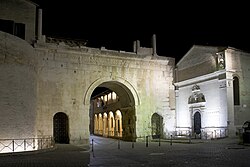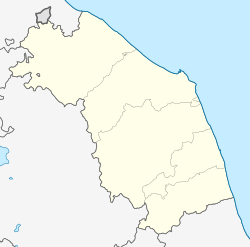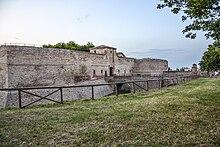For other uses, see Fano (disambiguation). Comune in Marche, Italy
| Fano | |
|---|---|
| Comune | |
| Comune di Fano | |
 Arch of Augustus Arch of Augustus | |
 Coat of arms Coat of arms | |
 Fano within the Province of Pesaro-Urbino Fano within the Province of Pesaro-Urbino | |
| Location of Fano | |
  | |
| Coordinates: 43°50′33″N 13°0′49″E / 43.84250°N 13.01361°E / 43.84250; 13.01361 | |
| Country | Italy |
| Region | Marche |
| Province | Pesaro e Urbino (PU) |
| Frazioni | Bellocchi, Caminate, Carignano, Carrara di Fano, Centinarola, Cuccurano, Falcineto, Fenile, Magliano, Marotta, Metaurilia, Ponte Sasso, Roncosambaccio, Rosciano, Sant'Andrea in Villis, Torrette di Fano, Tre Ponti |
| Government | |
| • Mayor | Luca Serfilippi (Lega) |
| Area | |
| • Total | 121 km (47 sq mi) |
| Elevation | 12 m (39 ft) |
| Population | |
| • Total | 60,978 |
| • Density | 500/km (1,300/sq mi) |
| Demonym | Fanesi |
| Time zone | UTC+1 (CET) |
| • Summer (DST) | UTC+2 (CEST) |
| Postal code | 61032 |
| Dialing code | 0721 |
| Patron saint | Saint Paternian |
| Saint day | 10 July |
| Website | Official website |
Fano (Italian: [ˈfaːno]) is a town and comune of the province of Pesaro and Urbino in the Marche region of Italy. It is a beach resort 12 kilometres (7 miles) southeast of Pesaro, located where the Via Flaminia reaches the Adriatic Sea. It is the third city in the region by population after Ancona and Pesaro.
History
| This section needs expansion. You can help by adding to it. (June 2008) |
An ancient town of Marche, it was known as Fanum Fortunae after a temple of Fortuna located there. Its first mention in history dates from 49 BC, when Julius Caesar held it, along with Pisaurum and Ancona. Caesar Augustus established a colonia, and built a wall, some parts of which remain. In 2 AD Augustus also built an arch (which is still standing) at the entrance to the town.


In January 271, the Roman Army defeated the Alamanni in the Battle of Fano that took place on the banks of the Metauro river just inland of Fano.
Fano was destroyed by Vitiges' Ostrogoths in AD 538. It was rebuilt by the Byzantines, becoming the capital of the maritime Pentapolis ("Five Cities") that included also Rimini, Pesaro, Senigallia and Ancona. In 754 it was donated to the Holy See by the Frankish kings.
The Malatesta became lords of the city in 1356 with Galeotto I Malatesta, who was nominally only a vicar of the Popes. Among the others, Pandolfo III resided in the city. Under his son, the famous condottiero Sigismondo Pandolfo Malatesta, Fano was besieged by Papal troops under Federico III da Montefeltro, and returned to the Papal administration. It was later part of the short-lived state of Cesare Borgia, and then part of the duchy of the della Roveres in the Marche.
During the Napoleonic Wars it suffered heavy spoliations; the city had an active role in the Risorgimento. In World War I Fano was several times bombed by the Austro-Hungarian Navy. During World War II it was massively bombed by Allied aeroplanes due to hit the strategic railway and street bridges crossing the Metauro river. When the Nazis withdrew from the town they destroyed all of the bell towers in the town.
During the 1916 Rimini earthquakes, two spires of Fano Cathedral collapsed, a large stucco angel fell in the Church of Sant'Agostino [it], and part of the belltower wall of the Church of Santa Maria del Gonfalone [it] collapsed. Part of a wall of the Church of San Paterniano collapsed. The earthquake of 16 August caused an exodus from the town.
Main sights
Religious structures
- Fano Cathedral: (12th century), which was erected over a pre-existing cathedral destroyed by a fire in 1111. The current façade is from the 1920s restoration, but is similar to the original. The interior has a nave and two aisles. No remnants of the town's namesake temple have been uncovered, nor any of the basilica that (we are told) Vitruvius built there.
- San Domenico
- San Pietro in Valle:
- San Paterniano: (16th century) with a Renaissance cloister.
- San Francesco: church housing the tombs of Pandolfo III Malatesta (designed by Leon Battista Alberti) and his first wife Paola Bianca Malatesta.
- Santa Maria Nuova: (1521) Church has an ancient portal and two works by Perugino (Annunciation of Fano and Fano Altarpiece, the latter including perhaps an intervention by Raphael).
Outside the city, in the place called Bellocchi, is the church of St. Sebastian (16th century), for the construction of which parts of the ancient cathedral were used.
Secular structures
- Arco d'Augusto: The upper story of this Roman gate was destroyed in a siege conducted on the order of Pope Pius II in 1463, although a bas-relief of it was made by Bernardino di Pietro da Carona in 1513 on an adjacent wall of the annexed church and the loggia of St. Michael, the former having a noteworthy Renaissance portal.
- Corte Malatestiana: built after 1357 by Galeotto I Malatesta. The 14th-century section includes a great vaulted hall (probably part of the first residence of the Malatesta in the city) and a small turret. The modern part was built under Pandolfo III in 1413–23. The current edifice was heavily restored in the 20th century, but original are the mullioned windows in Gothic style as well as the staircase and the loggia from a 16th-century restoration. Also noteworthy is the Borgia-Cybo Arch (late 15th century). The palace is connected to the Palazzo del Podestà by a modern bridge, probably present also in the original structure.
- Rocca Malatestiana: (Malatesta Castle) was partially destroyed in 1944. The most ancient part dates probably from pre-existing Roman and medieval fortifications. The castle in its current form was begun in 1433 or 1438 by Sigismondo Pandolfo Malatesta. The now missing mastio was erected in 1452. Here Sigismondo's son, Roberto, was besieged by Papal Troops in 1463 and signed the peace treaty that ended the Malatesta domination of Fano.
- Museo Civico of Fano: (Archeological Museum and Art Gallery), located inside the Palazzo Malatestiano, contains paintings by Guercino, Michele Giambono, and Giovanni Santi.
- Palazzo del Podestà or della Ragione (built from 1229 in Romanesque-Gothic style). The interiors are in Neoclassicist style, and it houses a museum with archaeological findings, coins, medals, and an art gallery with works by Guido Reni, Domenichino and others.
- Fontana della Fortuna (Fountain of Fortune) (17th century).
Culture
- Fano dei Cesari is held annually in July or August for a week. During the week there are a variety of cultural events ending with a parade in Roman costumes and chariot races.
- The Fano Jazz by The Sea festival is held annually for one week.
- The library, the Biblioteca Federiciana, was established on 17 November 1720.
Sports
The Ultimate Frisbee Fano Association was created in 2001. The association has 4 teams: Croccali (mixed), Mirine (women), Spaccamadoni (men) and Angry Gulls (juniors). Since 2001, the association has won 8 Italian championships.
Alma Juventus Fano 1906 is the local football team who play at the Stadio Raffaele Mancini.
Notable people
- Sebastiano Ceccarini (1703–83), painter
- Clement VIII, Ippolito Aldobrandini (1536–1605), pope
- Menahem Azariah da Fano (1548, Fano – Mantua, 1620), famed Rabbi and Kabbalist
- Antonio Giuglini (1825–65), opera tenor
- Fathi Hassan (born 1957), artist
- Carlo Magini (1720–1806), painter
- Roberto Malatesta (c. 1441-1442–1482), condottiero and lord of Rimini
- Laura Martinozzi (1639–87), duchess, mother of Mary of Modena
- Bruno Radicioni (1933–97), painter, sculptor and ceramist
- Ruggero Ruggeri (1871–1953), actor
- Giacomo Torelli (1608–78), set designer
- Franco Trappoli, Mayor of Fano (1980–83) and first Buddhist member of the Italian Parliament
International relations
See also: List of twin towns and sister cities in ItalyFano is twinned with:
 Rastatt, Germany
Rastatt, Germany Saint-Ouen-l'Aumône, France
Saint-Ouen-l'Aumône, France St. Albans, United Kingdom
St. Albans, United Kingdom Stribro, Czech Republic
Stribro, Czech Republic Binbrook, Ontario,Canada
Binbrook, Ontario,Canada Sault Ste Marie,Canada
Sault Ste Marie,Canada
See also
Notes
- "Superficie di Comuni Province e Regioni italiane al 9 ottobre 2011". Italian National Institute of Statistics. Retrieved 16 March 2019.
- "Popolazione Residente al 1° Gennaio 2018". Italian National Institute of Statistics. Retrieved 16 March 2019.
- Richard J.A. Talbert, ed. (2000). Barrington Atlas of the Greek and Roman World: Map-By-Map Directory. Vol. I. Princeton, NJ and Oxford, UK: Princeton University Press. p. 609. ISBN 0691049459.
- "Terremoto del 17.05.1916, Alto Adriatico (Rimini)" [Earthquake of 17 May 1916, High Adriatic (Rimini)]. www.lavalledelmetauro.it. 28 July 2004. Archived from the original on 4 January 2024. Retrieved 4 January 2024.
- "Il terremoto di Romagna e delle Marche" [The earthquake of Romagna and the Marche] (PDF). Il Resto del Carlino (in Italian). Bologna. 19 August 1916. p. 2. Archived (PDF) from the original on 12 January 2024. Retrieved 11 January 2024.
- Illustrated in Roberto Weiss, 1969. The Renaissance Discovery of Classical Antiquity, facing p. 151.
- "Codici sconto Viaggi e Vacanze 2023". Archived from the original on 28 June 2013. Retrieved 16 June 2013.
- "294° anniversario della Biblioteca Federiciana: Ricerche e curiosità sul Kitab Salat al-Sawai". Archived from the original on 9 May 2016. Retrieved 26 April 2016.
External links
- Fano homepage (in Italian)
- The Fano Club at Baylor University